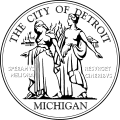Famous works
Pewabic Pottery produces many kinds of hand made decorative objects. They are part of the collections of the Detroit Institute of Arts, the University of Michigan Museum of Art, and the Freer Gallery of Art. [9] [10] [6]
Under Mary Stratton's artistic leadership, Pewabic Pottery employees created lamps, vessels, and architectural tiles. Architectural pieces have been a staple in Pewabic's history. They were known for their iridescent glazes. Architectural tiles were used in churches, concert halls, fountains, libraries, museums, schools and public buildings. The studio's work graces numerous edifices throughout Michigan and the rest of the United States. Noteworthy examples include Herzstein Hall at Rice University in Houston, Texas, [12] and the Shedd Aquarium in Chicago, Illinois. [9] Detailed maps of public installations in the Detroit Metropolitan Area and the U.S.A. are available. [13]
Particularly notable was the company's work at the Basilica of the National Shrine of the Immaculate Conception in Washington, D.C., consisting of arches outlined with iridescent Pewabic tile, huge ceramic medallions set in the ceiling, and fourteen Stations of the Cross for the crypt. [6]
Pewabic's design team continues to create ornate tile conceptions for public and private buildings. Contemporary installations include Comerica Park, home of the Detroit Tigers, Detroit Medical Center Children's Hospital, five Detroit People Mover stations, Third Man Records (Detroit), stations for the Q-Line, and the Herald Square in New York City.
This page is based on this
Wikipedia article Text is available under the
CC BY-SA 4.0 license; additional terms may apply.
Images, videos and audio are available under their respective licenses.






